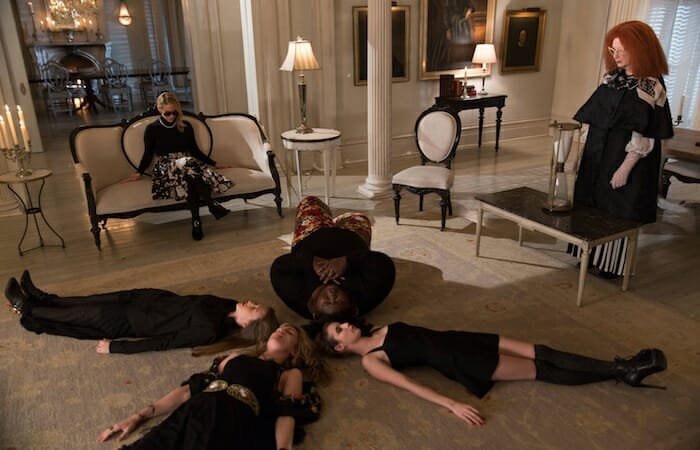By Emily Holland · January 31, 2014

In what is perhaps the most rushed ending of any television show that wasn’t spontaneously cancelled, American Horror Story wrapped up its third season, subtitled Coven, rather unsatisfyingly. To say that the final episode was “disappointing” would be somewhat inaccurate—the episode itself had merit and purpose and twists, elements missing from the rest of the season.
Unlike the first two seasons of American Horror Story, this third exploration into the horror genre stuck more to gore and blood than the intense scariness of the first two. Rooted in deep historical facts and diversions about Salem witches, slave owners, witch hunters, and voodoo rituals, Coven culminated with returning its focus to the witches’ battle to discover their next leader, or, Supreme. The final episode, called “The Seven Wonders,” after the seven tests used to reveal the true Supreme, skated over the previous turmoil that comprised the episodes leading up to the finale.
Since the beginning of the season, finding the new Supreme was always the goal. Of course, there needed to be diversions along the way, but these diversions and rising action were just too much for the 13 episodes to satisfyingly wrap up. The climax of the season occurred far too late, making a highly skewed plot diagram and one that did not do any of the main stories or characters justice.
This pacing problem purely made the finale less interesting and very anticlimactic. However, when we focus on the finale as a separate entity from the rest of the misdirected season, there are some redeeming qualities.
The episode began with a musical number, though this one was much different than the sing-along dance-filled spectacle seen in the second season. Bringing back Stevie Nicks from earlier in the season, Coven decided to start its wrap-up with Nicks’ song “Seven Wonders,” appropriate for the episode’s plot but set a strange tone that quickly disappeared after Nicks left the screen.
Not confident in whether to be humorous or shocking or scary, the finale seemed to blend the three together. Sometimes this worked well, like when the battle for supremacy became less about the title and more about showing everyone who was the baddest bitch of them all. These bouts of humor and quippy lines reminded viewers that these witches are taking part in something far more mature than they are at their young age. It kept them human, or as human as possible.
One of my biggest issues with the episode, and the season in general, was its half-hearted killing and resurrecting of characters. Sure, resurrection is a power in this witch-filled world, but this useless switch from alive to dead to alive and sometimes dead again seemed to be more of a result of poor writing than a useful plot twist or device. There was one key death and resurrection in the finale, which may have been the only one in the season that was somewhat necessary. There were too many disappointing or unfitting deaths in the finale, though, and it seemed like when the writers were at a loss of what to do with a character, they would just decide to kill her off.
Perhaps the most heartbreaking death was that of Misty Day, the swamp witch portrayed by Lily Rabe. In one of the seven tests, the witches had to descend into Hell and return before sunrise or risk being trapped forever. Misty, who was perhaps the only truly good witch of the group, got caught up in her doomed afterlife where she would resurrect a dead frog in a science class and then be forced to kill it over and over again. Unable to escape back to the real world, her body dissolved and she became stuck in Hell forever. This was as scary as the season became—it wasn’t a typical horror movie-scary, but a kind of existential horror that should have been explored further. The real terror comes knowing that, had Misty died in real life, she probably would have wound up in Heaven. Instead she chose to send herself to Hell and, in effect, doomed herself for eternity.
The other witches recover too quickly from Misty’s death and other traumas in the episode, although there finally is a Supreme at the end. Cordelia Foxx (Sarah Paulson), daughter of the previous Supreme Fiona Goode (Jessica Lange), emerges as the true leader after her long-suppressed powers are revealed. This was a good fit, but it seemed rushed, again a byproduct of the season itself. Hopefully the next installment in the American Horror Story series will focus less on complicated tangents and more on good pacing and good characters.